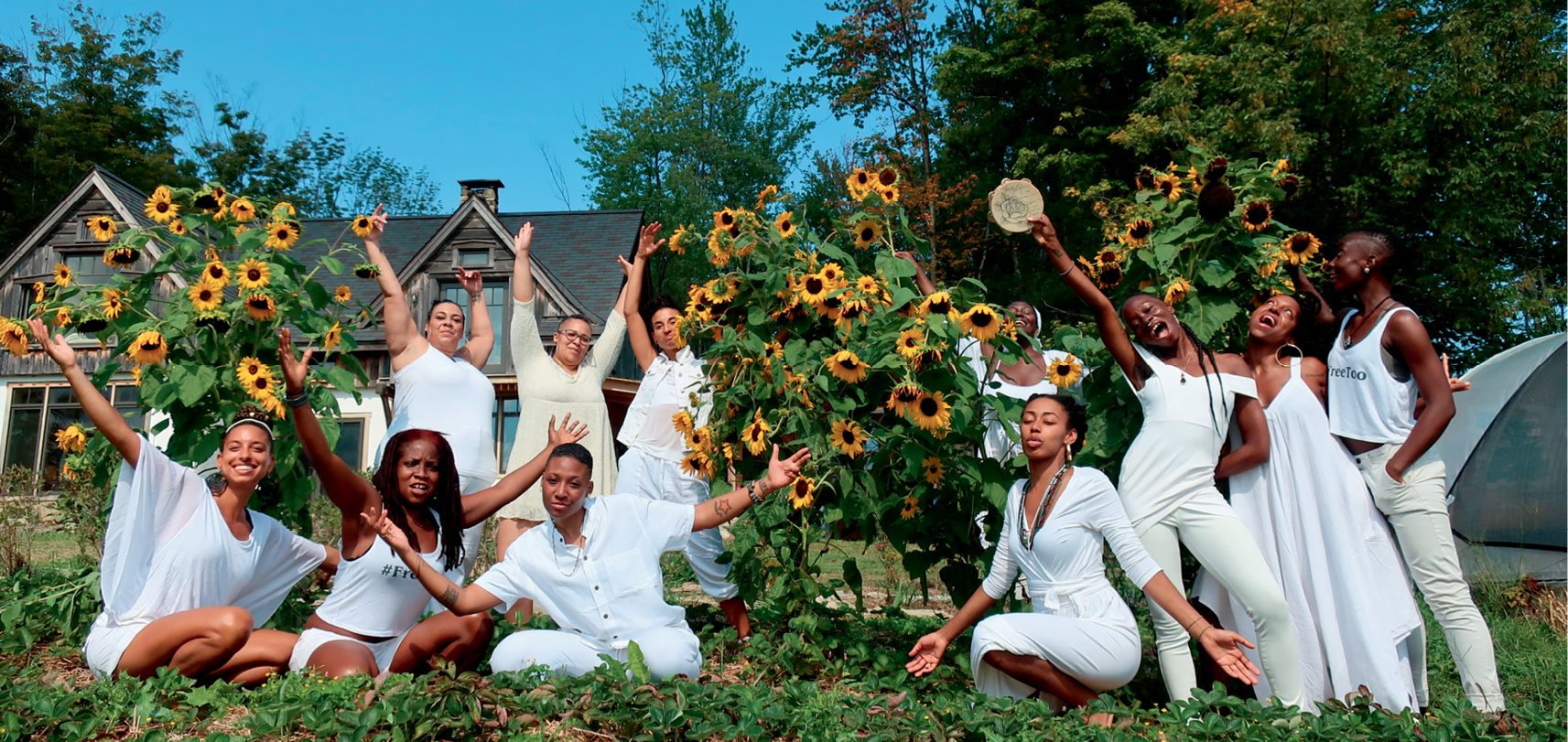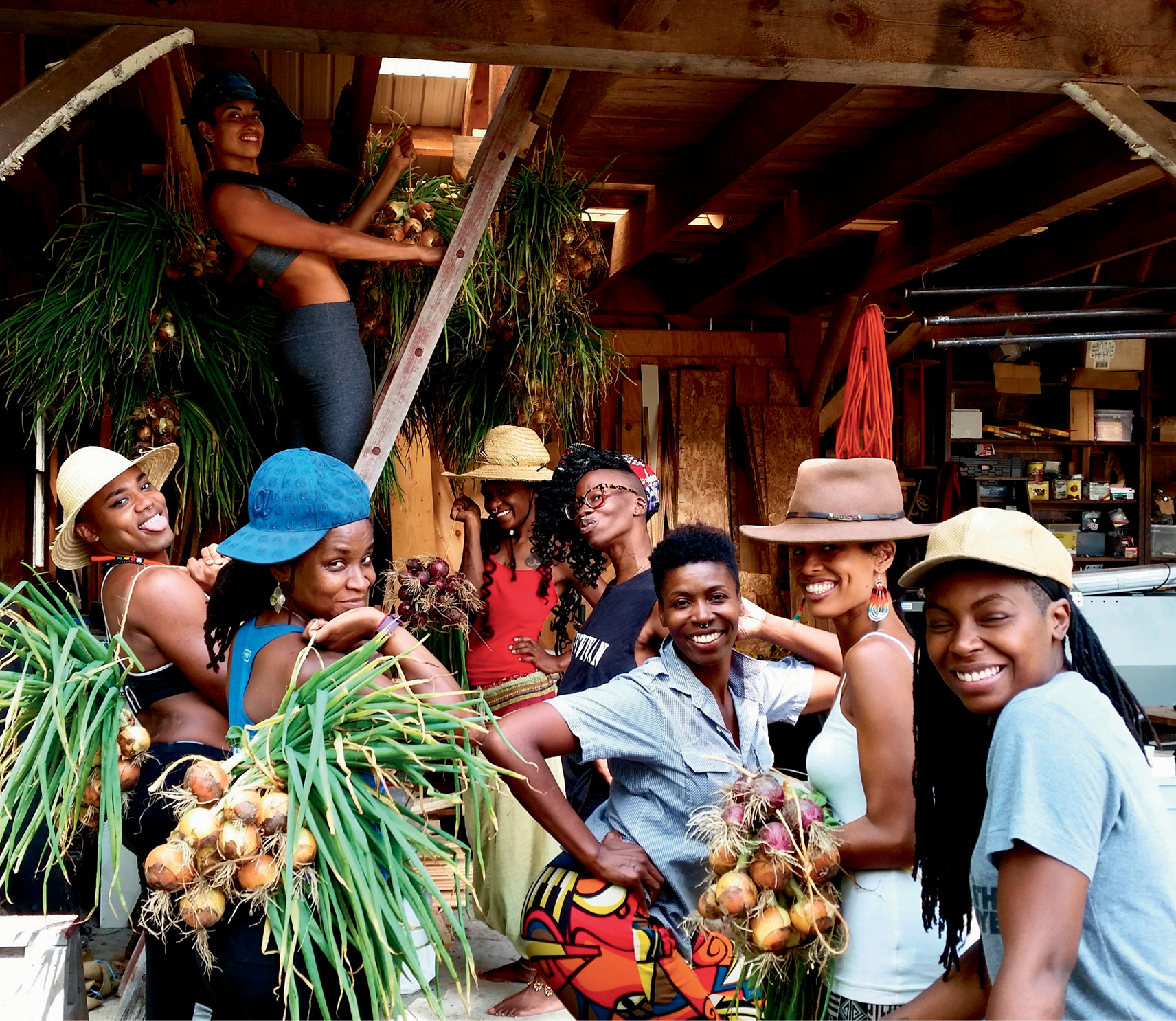
Learners in the Soul Fire Afro-Indigenous Farming Immersion gather on graduation day.
BLACK TO THE LAND
LEAH PENNIMAN

Learners in the Soul Fire Afro-Indigenous Farming Immersion gather on graduation day.
Our ancestral grandmothers in the Dahomey region of West Africa braided seeds of okra, molokhia, and Levant cotton into their hair before being forced to board transatlantic slave ships. They hid sesame, black-eyed pea, rice, and melon seeds in their locks. They stashed away amara, kale, gourd, sorrel, basil, tamarind, and kola in their tresses. The seed was their most precious legacy, and they believed against odds in a future of tilling and reaping the earth. They believed that we, Black descendants, would exist and that we would receive and honor the gift of the seed.1
Along with the seed, our grandmothers also braided their ecosystemic and cultural knowledge. African people, expert agriculturalists, created soil testing systems that used both taste to determine pH and touch to determine texture. Cleopatra developed the first vermicomposting system, warning citizens that they would face harsh punishment for harming any worm.2 Ghanaian women created “African Dark Earths”—a compost mixture of bone char, kitchen scraps, and ash that had built up over generations—which captured carbon and fertilized crops.3 African farmers developed dozens of complex agroforestry systems, integrating trees, herbs, annuals, and livestock. The farmers built terraces to prevent erosion and invented the most versatile and widely used farming tool: the hoe.4 Our people invented the world’s initial irrigation systems five thousand years ago and watered the Sahel with foggaras that are still in use today. They domesticated livestock and established rotational grazing that created fertile ground for grain crops. Our ancestors created sophisticated communal labor systems, cooperative credit organizations, and land-honoring ceremony. On Turtle Island, Black agriculturalists like Booker T. Whatley, George Washington Carver, Fannie Lou Hamer, and Harriet Tubman brought us the CSA (community-supported agriculture), organic/regenerative farming, cooperative farms, land trusts, and herbalism. Even as the colonizers raped the soil of 50 percent of its carbon in their first generation of settling, we used ancestral techniques like mounding, deep mulching, plant-based toxin extraction, and cover cropping to call life back into the soil. Our grandmothers braided all this wisdom and more into their hair and brought it across the Middle Passage. It is our heritage.
Of course, the project of the Empire is to make us forget, to confuse us and colonize our hearts, to make us name the land “enemy” and relinquish all claims of belonging. The DNA of the food system in the United States is the stolen land of Indigenous people and the stolen labor of African people. This DNA remains intact and unrectified. Even after emancipation, the Black codes, convict leasing, and sharecropping kept Black farmers in a state of neoslavery. When our folks fled racial terror, the more than forty-five thousand lynchings and house burnings in the South, as part of the Great Migration, that labor force was replaced with “guest workers” born outside the borders, and subject to unfair labor conditions.5 The Black farmers who remained in the South, attempting to hold on to their land, were discriminated against by the federal government and denied access to the USDA programs to which they were entitled. In the North, Black folks attempting to access land met other forms of discrimination—redlining, denial of mortgages through the G.I. Bill, and the persistent 16:1 White/Black wealth gap that originated with the ten trillion dollars gained from the unpaid labor of our enslaved forebears.6 We further faced food apartheid, that system of segregation that meant little to no availability of fresh, culturally appropriate foods in our neighborhoods, and the resultant epidemic of diabetes, obesity, and heart disease. The Empire is pleased when we turn our backs on the Earth, allowing White people to control 98 percent of the farmland in this country, consenting to their ownership of the soil, the groundwater, the minerals, and the food supply.
Yet, in every generation there were Black people who remembered the gift of the seed and the legacy of belonging to the land. We pay homage to one such rememberer, Fannie Lou Hamer, who said, “When you have 400 quarts of greens and gumbo soup canned for the winter, no one can push you around or tell you what to do.” In 1969, Hamer founded the Freedom Farm Cooperative on forty acres of prime Delta land. Her goal was to empower poor Black farmers and sharecroppers who had suffered at the mercy of White landowners. She said, “The time has come now when we are going to have to get what we need ourselves. We may get a little help, here and there, but in the main we’re going to have to do it ourselves.” The co-op consisted of fifteen hundred families who planted cash crops, like soybeans and cotton, as well as mixed vegetables. They purchased another 640 acres and started a “pig bank” that distributed livestock to Black farmers. The farm grew into a multifaceted self-help organization, providing scholarships, home-building assistance, a commercial kitchen, a garment factory, a tool bank, agricultural training, and burial fees to its members. Thank you, Mama Hamer, for keeping the seed alive.7
The seed is passed to you, Black child of Black gold. If we do not figure out how to continue the legacy of our agricultural traditions, this art of living in a sacred manner on land will go extinct for our people. Then, the KKK, the White Citizens’ Councils, and Monsanto would be rubbing their hands together in glee, saying, “We convinced them to hate the Earth and now it’s all ours.” We will not let the colonizers rob us of our right to belong to the Earth and to have agency in the food system. We belong here, bare feet planted firmly on the land, hands calloused with the work of sustaining and nourishing our community.

Healers from Harriet’s Apothecary, Brooklyn, New York, prepare to offer a community healing village at Soul Fire Farm.

Healers from Harriet’s Apothecary, Brooklyn, New York, hang onions to cure in the barn at Soul Fire Farm.

(L to R) Chanelle Crosby, Fresh Roberson, and Noah McDonald participate in the 2018 Soul Fire Afro-Indigenous Farming Immersion.

Alixa Garcia and Donnay Edmund harvest garlic at Soul Fire Farm.
1. Carney, Judith. Black Rice: The African Origins of Rice Cultivation in the Americas (Cambridge, MA: Harvard University Press, 2001).
2. Minnich, Jerry. The Earthworm Book: How to Raise and Use Earthworms for Your Farm and Garden (Emmaus, PA: Rodale Press, 1977).
3. Fairhead, James et al., “Indigenous African Soil Enrichment as a Climate-Smart Sustainable Agriculture Alternative,” Frontiers in Ecology and the Environment 14, no. 2 (2016): 71–76.
4. Schons, Mary. “African American Inventors II,” National Geographic, June 21, 2011. www.nationalgeographic.org/news/african-american-inventors-19th-century.
5. Regaining Ground: Cultivating Community Assets and Preserving Black Land (New York: Center for Social Inclusion, 2011). www.centerforsocialinclusion.org/wp-content/uploads/2014/07/Regaining-Ground-Cultivating-Community-Assets-and-Preserving-Black-Land.pdf.
6. Shin, Laura. “The Racial Wealth Gap: Why a Typical White Household Has 16 Times the Wealth of a Black One,” Forbes, March 26, 2015. www.forbes.com/sites/laurashin/2015/03/26/the-racial-wealth-gap-why-a-typical-white-household-has-16-times-the-wealth-of-a-black-one.
7. “Fannie Lou Hamer Founds Freedom Farm Cooperative,” SNCC Digital Gateway. snccdigital.org/events/fannie-lou-hamer-founds-freedom-farm-cooperative/.
PENNIMAN